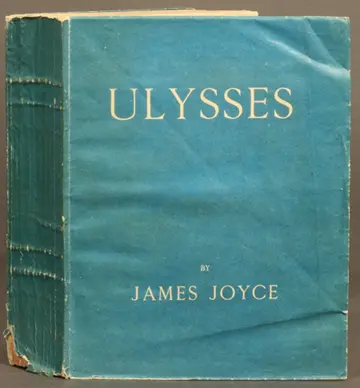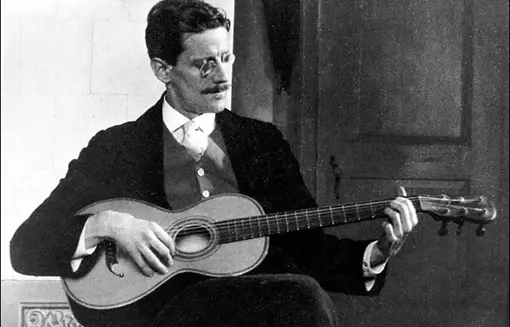To blag (v): to sound like you know what you’re talking about when you don’t
The Blagger’s Guide to Literature (n): an invaluable resource for those who wish to blag about books without actually reading them.
Blagfact: Joyce suffered from a lifelong fear of dogs and thunderstorms.
Blagfact: Joyce had an exceptionally fine tenor voice. He once considered trying to make his living as a singer.
Blagfact: Joyce eloped with Nora Barnacle in 1904. He didn’t meet her family until five years later, in 1909.
Blagfact: Joyce enjoyed writing dirty love letters to his wife that would make Howard Stern blush.
‘Once upon a time and a very good time it was there was a moocow coming down the road and this moocow that was coming down the road met a nicens little boy named baby tuckoo…’
Beatrix Potter on acid? No. This is the opening line from A Portrait of the Artist as a Young Man and it might give you a clue as to why Joyce, famous as he is, has to be one of the most unread authors on the planet. Joyce is so impenetrable that there are support groups dedicated to helping readers get through Finnegan’s Wake: literary versions of Weight Watchers, where you turn up each week to confirm how much you’ve read, the fear of missing your goal being the only thing that makes you turn the required number of pages.
You don’t read Joyce for pleasure, you read him for being able to say you’ve read him. But if you don’t have the time, or the spare neural disc space to devote to unraveling the Joycean mysteries, but happen to find yourself trapped in a pub by the banks of the Liffey with only a Joyce expert for company, you can still blag your way through a pint of Guinness with the assistance of this handy guide.
Just the facts ma’am
James Augustine Aloysius Joyce was born in Dublin in 1882, the oldest of ten children. He came from a relatively prosperous family, which slid gradually into bankruptcy during Joyce’s childhood, as a result of his father’s alcoholism. Joyce was also a heavy drinker. He died in Paris in 1941 (Virginia Woolf died the same year), from a perforated ulcer. During his lifetime he produced four major works of fiction: Dubliners, The Portrait of the Artist as a Young Man, Ulysses and Finnegan’s Wake.
Only four? Why is he so famous?
Joyce is credited with writing the first truly modern novel, although he was one of several writers who were experimenting with new models of writing at that time. Virginia Woolf, T S Eliot and Ezra Pound were all contemporaries and you could argue that Proust actually made the first break from traditional forms with A La Recherche Du Temps Perdu. Still, Joyce’s Portrait of the Artist was probably the first successful attempt at using a stream of consciousness style. Joyce wanted to capture the character of his protagonist, Stephen Dedalus, by reporting the thoughts in his head rather than the actions surrounding him, a method he went on to perfect (if that’s the right word) with Ulysses. Finnegan’s Wake is an entirely different kettle of fish. We’ll come to that later.
How did he get published in the first place?
With great difficulty. Joyce’s story is a classic tale of persistence. His collection of short stories, The Dubliners, took nine years to find a publisher. Two previous attempts to get it into print were frustrated by the printers themselves, who refused to deal with what they saw as pornographic content (which compared to today’s material was tamer than a magician’s bunny). Joyce’s stories outraged sensitive typesetters so much, that they burned all the copies of the book. He managed to rescue only one, by subterfuge. History does not record how Joyce managed to save that copy, but I’m guessing he told a sympathetic typesetter it was his evening’s wank material.
But experimental writers rarely make much money. How did he support himself?
Ironically, this foremost experimenter with the possibilities of language supported himself and his family (partner Nora Barnacle and children George and Lucie) by teaching English at the Berlitz school in Trieste (then part of Austria). Luckily for his students, Joyce taught them regular English, not the kind he wrote. Otherwise there would probably be members of the Trieste aristocracy going around calling people ‘tollerday donsk’ and ‘tolkatiff scowegian’ and hoping to be understood.
But Joyce always had itchy feet. Although all his work is set in Ireland, apart from the occasional visit, he avoided the Emerald Isle whenever possible. Perhaps he was worried about those typesetters. After Trieste, Joyce moved to Zurich, where Ezra Pound introduced him to Harriet Shaw Weaver, a committed feminist who became convinced Joyce was a genius and, handily, had inherited a fortune from her mother. Weaver became Joyce’s sponsor and without her support it’s unlikely either Ulysses or Finnegan’s Wake would have been completed. Joyce fanatics think of Weaver as a heroine, whereas the rest of us probably feel there might have been better causes for her to support. Like stray cats or something.

So what are his books about?
Dubliners is the first and probably the most accessible of Joyce’s works. It’s a collection of 15 short stories, probably best described as ‘slice of life’ pieces. Already Joyce was beginning to break step with conventional narrative – character and story arcs are barely discernible – his aim being to capture the essence of his home town, what he called its ‘special odor of corruption’ and ‘paralysis’. Religion, Irish Nationalism, Celtic myth and legend all find their way into the stories, which are often set against a background of Ireland’s famous drinking culture: alcohol finds its way into almost every tale.
A Portrait of the Artist as a Young Man was the book which made Joyce’s name. Initially published as a serial in Weaver’s avant garde literary magazine, The Egoist, Joyce’s first full length novel started life as the story ‘Stephen Hero’, the title giving away Joyce’s Homeric aspirations. The protagonist ended up with the name Stephen Dedalus, again an allusion to the Daedalus of Greek legend, the father of Icarus and creator of wings. Already you can sense the potent mix of legend and fiction which made Joyce so alluring to readers of the time and since. Portrait is a demanding, but not impossible read and for blagging purposes, is worth a try. It’s short too – another important advantage if (like me) you find the lack of structure numbing. But if you don’t fancy reading it, all you need to know is that the book follows Stephen’s early life and young manhood, recounting in a stream of consciousness fashion, his artistic awakening and rebellion against the social and religious mores of the day.
Portrait, which came out at the same time as Dubliners (eventually printed in London, where the typesetters were less prone to moral outrage), made Joyce’s name. From obscurity he became the Brett Easton Ellis of the day: both notorious and feted. He immediately began work on something new. Something longer. Ulysses was the result. By now, you’ll be getting that Joyce saw himself as an Irish version of an ancient Greek legend spinner. His attempt at an Odyssey took one day in the life of Leonard Bloom, an advertising canvasser living in Dublin. Not one to waste resources, Joyce also uses Stephen Dedalus as Telemarchus to Bloom’s Ulysses. The other main character is Molly, Bloom’s wife who takes the Penelope role. So far so good. Basically, Ulysses uses the same technique as Portrait but over a tighter time frame (hours instead of years) and with a more obvious reference to its Greek underpinnings. But the big difference between this and Joyce’s earlier work is in his use of language. Ulysses is the book where Joyce begins to depart from internal monologue and thoughts (weird though that can be) and starts to incorporate all kinds of other material: puns, street signs, letters, slogans and a whole load of allusions to other literary works including Shakespeare, Wagner, the Arabian Nights and the Bible. In fact, if Joyce had obtained a copy of the Koran, he probably would have stuck bits of that in there too. In which case Ulysses would probably still be banned, instead of just being on the blacklist (in the US) for 10 years (until 1933 when the ban was lifted after a famous court case).
Here’s a sample of what Joyce got up to in Ulysses: ‘The note of banishment from the heart, banishment from home, sounds uninterruptedly from The Two Gentlemen of Verona onward til Prospero breaks his staff, buries it certain fathoms in the earth and drowns his book, It doubles itself in the middle of his life, reflects itself in another, repeats itself, protasis, epitasis, catastatis, catastrophe.’
And also this: ‘Come forth Lazarus! And he came fifth and lost the job.’
The banning of Ulysses made it an instant success. At 230,000 plus words, it was literally a very big success. But Ulysses is a wafer thin after dinner mint compared with Joyce’s final All-You-Can-Eat MegaWhopper buffet with all the trimmings novel: Finnegans Wake.
FW (as its fans call it) departs from any pretense of being a story. There’s no plot, no characters, no structure apart from its division into four books. Joyce even made up many of the words (hence ‘tolladay’ and ‘tolkatiff’). Having learned Norwegian to read Ibsen in the original, Joyce perhaps felt his readers should be put to a similar challenge. FW is probably best described as the bastard lovechild of the Arabian Nights and the Egyptian Book of the Dead, with the Norse sagas for a godfather. When cornered on the subject of FW, for blagging purposes all you need to know is the following: post-structuralists love it, it’s a remarkable example of intertextuality and (to quote Samuel Beckett) if you don’t understand it, it is because you are too decadent to receive it.

Does everyone think Joyce deserves his reputation?
Short answer: no. Roddy ‘The Commitments’ Doyle’s comment on FW was, ‘I only read three pages of it and that was a tragic waste of time.’ Doyle also said that Ulysses ‘could have done with a good editor.’ In Ireland, Joyce tourism is a big money spinner (there are Joyce pubs, Joyce walks, and even a special ‘Bloomsday’ to celebrate the day during which Ulysses is set) and that may well be why writers like Doyle and Flann O’Brien feel he’s overrated.
But taking the broad view and ignoring the hype and the commemorative mugs, Joyce is a literary figure to contend with. He genuinely did change the rules of fiction. Before Joyce there were rules. After Joyce, those rules no longer existed. His legacy is enormous: you can trace his influence in the work of Raymond Carver, Charles Bukowski, James Kelman and Jon ‘If Nobody Speaks of Remarkable Things’ McGregor, just to name a very few.
And to quote Joyce himself on Ulysses: ‘I've put in so many enigmas and puzzles that it will keep the professors busy for centuries arguing over what I meant, and that's the only way of insuring one's immortality.’
In that respect, he certainly succeeded.
Stop Press: as evidence of Joyce's continued popularity, BBC Radio 4 devoted the whole of Saturday 16 June to a reading of Ulysses, from start to bitter end.

About the author
Cath Murphy is Review Editor at LitReactor.com and cohost of the Unprintable podcast. Together with the fabulous Eve Harvey she also talks about slightly naughty stuff at the Domestic Hell blog and podcast.
Three words to describe Cath: mature, irresponsible, contradictory, unreliable...oh...that's four.







